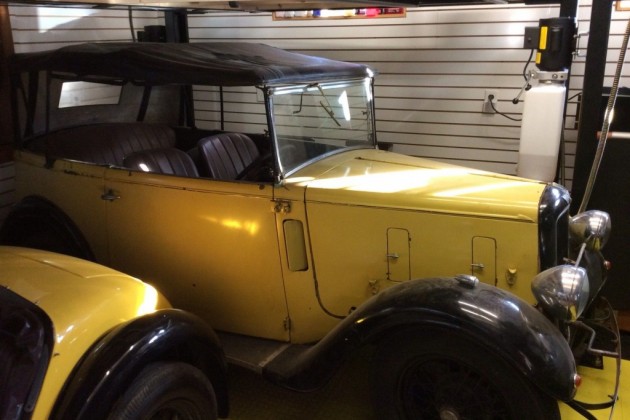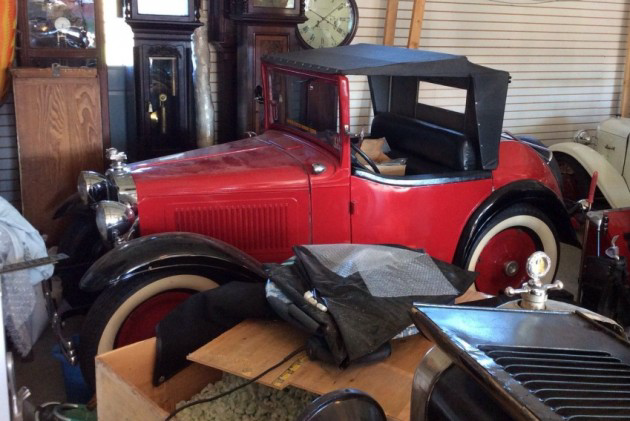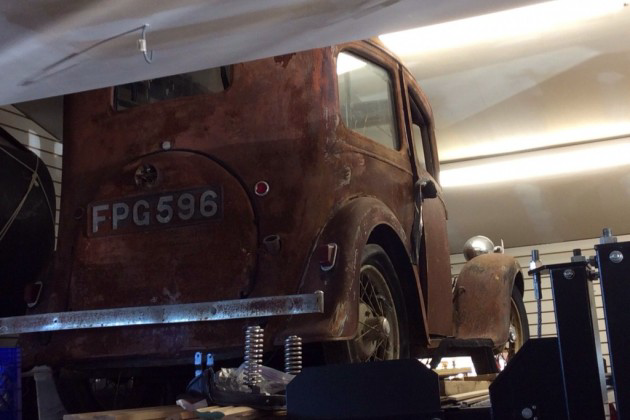The Austin 7 was Britain’s equivalent of the Model T; the first common truly affordable “people’s car” that was within the reach of most families (used, if not new). Although not even close to the Model T’s proliferation with less than 300,000 made, the little Austin endeared itself to many Brits, and was produced under license both as the first BMW, the Dixi, and also in the United States as the American Bantam. An enthusiast in Barre, Vermont has decided to sell their collection of three of these little cars to pay for their daughter’s college tuition. The auction listing can be found here on eBay, where the opening bid is $11,500 for all three vehicles. All of the cars have been stored for quite some time with the intention of eventually being restored. There is at least one other car that I think is a 7 as well in the picture above that isn’t for sale yet, but who knows what will come in the future.
The seller describes the yellow and black car as the gem of the collection. It was imported into California back in the 1950’s and then made it’s way to Georgia, and finally to Vermont. The seller planned to keep the cosmetics “as-is” and refurbish the mechanical components as needed. Supposedly the vehicle ran before the current owner’s purchase of the vehicle but apart from some oil in the cylinders, the seller has left the cars alone.
The second car in the auction is an American Austin or American Bantam (I’m not sure). American Austin cars were produced under license in Butler, Pennsylvania, but after the company went bankrupt, the reorganized company somehow produced similar cars without them being under license. This is a running and driving car, but the seller feels that the previous restoration was rather amateur and they feel some of the work should be re-done. Apparently the car was previously used in parades. The seller notes that the wheels and tires have been professionally done and that they are quite expensive.
The third car is the most interesting one to me. Wearing lots of surface rust and little else, I’m left wondering whether it’s paint was stripped and then left to oxidize or if it is just that worn of a finish. The seller bought this one from a farmer’s field in Texas, intending it as a parts car for the yellow and black car, and knows nothing of it’s history. I think I’d start out with some registration number inquiries with some of the British clubs; who knows what the history actually is? As it turns out, despite the dilapidated appearance, it’s pretty solid, and could become a driver in it’s own right. I think this is actually the car I’d start with, because making it run and drive but maintaining it’s current appearance would be really enjoyable. If you ended up with all three cars, which one would you start with?






These are real small cars, even by vintage British standards. The engines are small too, 750cc and a flathead design. My father in law had an Austin 7 engine in a small boat he had and the power was pretty modest, and so were the RPMs. I helped him out in finding out where to get parts in the UK because there seemed to be no sources in No America. I can’t see a lot of demand for these cars over here, especially as a lot of three. It might be better for the seller to offer them ‘over there’.
I can’t add much to this – the Austin 7 is well known in the UK, easy to fix and restore but it’s almost, as Dolphin says, a toy car in proportions. These cars would probably fetch the opening bid the seller wants in the UK/Europe so no incentive to pay shipping or import taxes when there are so many already here. At that price I can’t see them finding a European buyer.
The only thing I *can* add is this great pdf for people who end up with a British car with its original plates and might want to know where it came from – I’ve been using this document for years and it’s still up on the ‘net, but you might want to save a copy if you think it would come in handy.
http://www.metadyne.co.uk/pdf_files/CarReg.pdf
The registration ‘FPG’ tells me the car comes from Surrey (the south of England – generally a prosperous and well-off area of the country) originally, and sometime after 1932, but more likely to be a little later – 1935 or so. The ‘P’ was the original prefix that the county of Surrey got in 1903 when plates were first issued, the ‘G’ was added about twenty years later as registrations started to run out. Finally, the prefix ‘F’ would have been issued in the ’30s – APG, BPG, CPG…. FPG etc., as more and more cars were purchased.
Besides BMW and American Bantam they were also the basis for the first Datsun cars
Hi just to let you know the Rosengart ( French ) also came from the Austin stable, if you would like pics i have a 1932 Austin box RN and also a Rosengart 1938 sutol.Yours Dave Felton
I believe the other yellow car is an Austin “Nippy”.
Besides the listed and identified vehicles I see a modern Morris Minor but what are the other two?
The Austin was developed into a 750 cc late 1930’s single seat racer with a DOHC blown engine. Hot rodding Austins for racing was common before WWII. Our family had an Austin A40 in the early ’50s. Wooden floorboards even then.